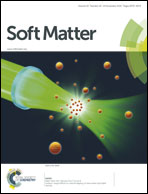Surface charge effects on optical trapping of nanometer-sized lipid vesicles†
Abstract
Optical trapping of nanometer-sized lipid vesicles has been challenging due to the low refractive index contrast of the thin lipid bilayer to the aqueous medium. Using an “optical bottle”, a recently developed technique to measure interactions of nanoparticles trapped by an infrared laser, we report, for the first time, quantitative measurements of the trapping energy of charged lipid vesicles. We found that the trapping energy increases with the relative amount of anionic lipids (DOPG) to neutral lipids (DOPC) in vesicles. Moreover, as monovalent salt is added into the exterior solution of vesicles, the trapping energy rapidly approaches zero, and this decrease in trapping energy strongly depends on the amount of anionic lipids in vesicles. A simple model with our experimental observations explains that the trapping energy of charged lipid vesicles is highly correlated with the surface charge density and electric double layer. In addition, we demonstrated selective trapping of a binary mixture of vesicles in different mole fractions of charged lipids, a strategy that has potential implications on charge selective vesicle sorting for engineering applications.


 Please wait while we load your content...
Please wait while we load your content...